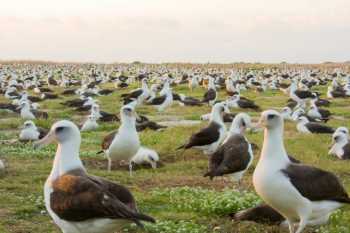Curt Storlazzi and colleagues of the U.S. Geological Survey have produced a report that addresses the likely effects of storm waves and sea-level rise on the low-lying North-western Hawaiian Islands – important breeding sites for both ACAP-listed Laysan Phoebastria immutabilis and Black-footed P. nigripes Albatrosses.
The USGS report was considered at the First Meeting of Population and Conservation Status Working Group (PCSWG1) held earlier this month in La Rochelle, France (click here for the meetings’ report to the Seventh Meeting of ACAP’s Advisory Committee).

At risk: Laysan Albatrosses on low-lying Midway Atoll. Photograph by Lindsay Young
The Working Group noted that the report recognised that Black-footed and Laysan Albatrosses are exceptional in that the vast majority of their world populations breeds on low-lying (<10 m asl) islands. Recent models that consider dynamic wave action, rather than passive “bathtub” models of inundation, predict greater loss than anticipated of breeding habitat at lower values of predicted sea level rise for several of the North-western Hawaiian Islands, including Laysan and Midway.
The PCSWG’s report concludes that “[t]hese more realistic models, in concert with accelerating sea level rise suggest repeated catastrophic reproductive failure in the future caused by loss of nest sites, resulting in population trajectories not easily predicted by current trends.”
Reference:
Storlazzi, C.D., Berkowitz, P., Reynolds, M.H. & Logan, J.B. 2013. Forecasting the Impact of Storm Waves and Sea-level Rise on Midway Atoll and Laysan Island within the Papahānaumokuākea Marine National Monument - a Comparison of Passive versus Dynamic Inundation Models. U.S. Geological Survey Open-File Report 2013-1069. 78 pp.
John Cooper, ACAP Information Officer, 28 May 2013

 English
English  Français
Français  Español
Español